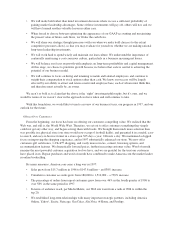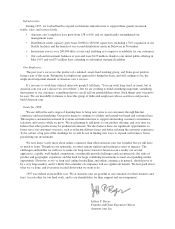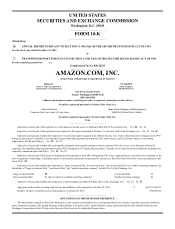Amazon.com 2015 Annual Report Download - page 19
Download and view the complete annual report
Please find page 19 of the 2015 Amazon.com annual report below. You can navigate through the pages in the report by either clicking on the pages listed below, or by using the keyword search tool below to find specific information within the annual report.9
The Seasonality of Our Business Places Increased Strain on Our Operations
We expect a disproportionate amount of our net sales to occur during our fourth quarter. If we do not stock or restock
popular products in sufficient amounts such that we fail to meet customer demand, it could significantly affect our revenue and
our future growth. If we overstock products, we may be required to take significant inventory markdowns or write-offs and
incur commitment costs, which could reduce profitability. We may experience an increase in our net shipping cost due to
complimentary upgrades, split-shipments, and additional long-zone shipments necessary to ensure timely delivery for the
holiday season. If too many customers access our websites within a short period of time due to increased holiday demand, we
may experience system interruptions that make our websites unavailable or prevent us from efficiently fulfilling orders, which
may reduce the volume of goods we sell and the attractiveness of our products and services. In addition, we may be unable to
adequately staff our fulfillment network and customer service centers during these peak periods and delivery and other
fulfillment companies and customer service co-sourcers may be unable to meet the seasonal demand. We also face risks
described elsewhere in this Item 1A relating to fulfillment network optimization and inventory.
We generally have payment terms with our retail vendors that extend beyond the amount of time necessary to collect
proceeds from our consumer customers. As a result of holiday sales, as of December 31 of each year, our cash, cash
equivalents, and marketable securities balances typically reach their highest level (other than as a result of cash flows provided
by or used in investing and financing activities). This operating cycle results in a corresponding increase in accounts payable as
of December 31. Our accounts payable balance generally declines during the first three months of the year, resulting in a
corresponding decline in our cash, cash equivalents, and marketable securities balances.
Our Business Could Suffer if We Are Unsuccessful in Making, Integrating, and Maintaining Commercial Agreements,
Strategic Alliances, and Other Business Relationships
We provide e-commerce and other services to businesses through commercial agreements, strategic alliances, and
business relationships. Under these agreements, we provide web services, technology, fulfillment, computing, digital storage,
and other services, as well as enable sellers to offer products or services through our websites. These arrangements are complex
and require substantial infrastructure capacity, personnel, and other resource commitments, which may limit the amount of
business we can service. We may not be able to implement, maintain, and develop the components of these commercial
relationships, which may include web services, fulfillment, customer service, inventory management, tax collection, payment
processing, hardware, content, and third-party software, and engaging third parties to perform services. The amount of
compensation we receive under certain of our commercial agreements is partially dependent on the volume of the other
company’s sales. Therefore, if the other company’s offering is not successful, the compensation we receive may be lower than
expected or the agreement may be terminated. Moreover, we may not be able to enter into additional commercial relationships
and strategic alliances on favorable terms. We also may be subject to claims from businesses to which we provide these
services if we are unsuccessful in implementing, maintaining, or developing these services.
As our agreements terminate, we may be unable to renew or replace these agreements on comparable terms, or at all. We
may in the future enter into amendments on less favorable terms or encounter parties that have difficulty meeting their
contractual obligations to us, which could adversely affect our operating results.
Our present and future e-commerce services agreements, other commercial agreements, and strategic alliances create
additional risks such as:
• disruption of our ongoing business, including loss of management focus on existing businesses;
• impairment of other relationships;
• variability in revenue and income from entering into, amending, or terminating such agreements or relationships; and
• difficulty integrating under the commercial agreements.
Our Business Could Suffer if We Are Unsuccessful in Making, Integrating, and Maintaining Acquisitions and
Investments
We have acquired and invested in a number of companies, and we may acquire or invest in or enter into joint ventures
with additional companies. These transactions create risks such as:
• disruption of our ongoing business, including loss of management focus on existing businesses;
• problems retaining key personnel;
• additional operating losses and expenses of the businesses we acquired or in which we invested;
• the potential impairment of tangible and intangible assets and goodwill, including as a result of acquisitions;
























